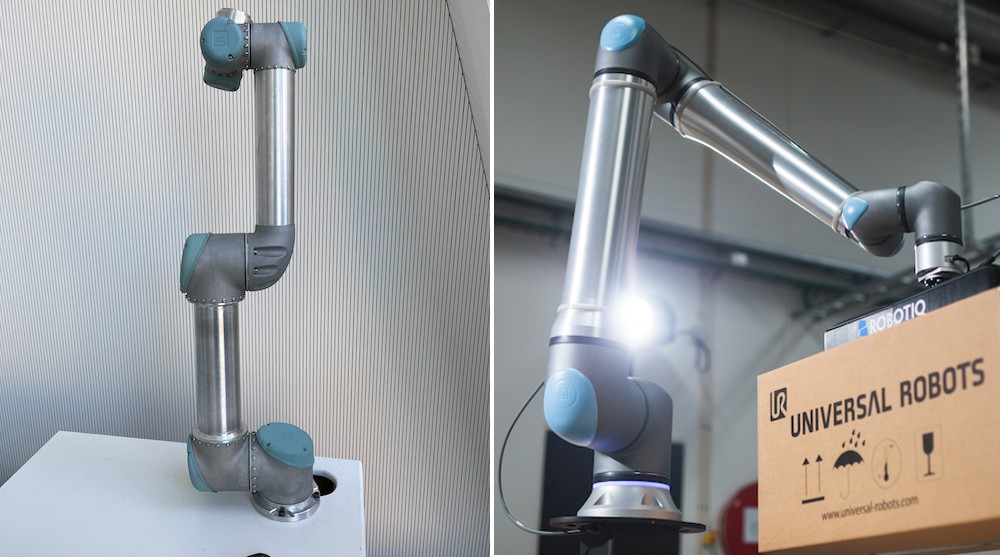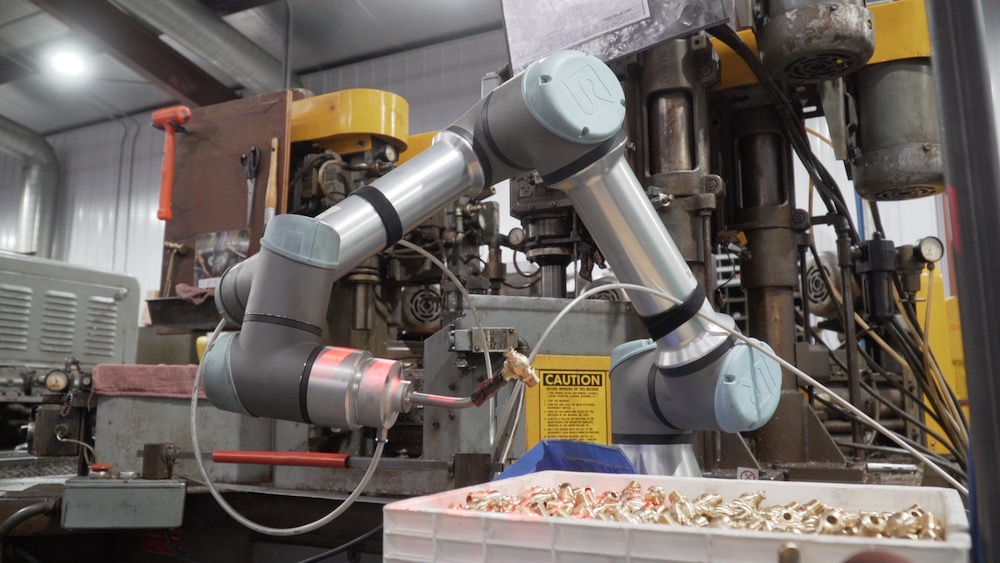|
Listen to this article  |

How it started vs. how it’s going: the first-ever cobot from Universal Robots (left) and the new UR20.
Denmark-based Universal Robots (UR) has sold more than 50,000 collaborative robot arms since it was founded. It has a network of 1,100-plus integrators, distributors and independent partners worldwide helping it grow the collaborative robotics market.
Earlier this morning at Automatica in Munich, Germany, UR introduced its fastest, strongest cobot arm to date: the UR20, which offers a 20 kg payload, 1750 mm reach and 30% more speed and torque compared to its existing models. The company is calling the UR20 “the most innovative cobot we have produced.” Of course, the UR20 wasn’t built overnight. It’s taken UR 17-plus years to get to this point.
We thought it would be fun to look back at UR’s journey and highlight some of the milestones along the way.
2005: Universal Robots launches
Universal Robots is officially founded by three students who met at the University of Denmark: Kristian Kassow, Esben Østergaard and Kasper Støy. Their goal was to make robotic technology accessible to small and medium-sized enterprises. An investment by Syddansk Innovation, a venture capital firm based in Odense, Denmark, made the establishment of the company possible.

UR’s first sold cobot, a UR5, being installed at Linatex. | Credit: Universal Robots
2008: UR sells its first cobot
UR’s first cobot sale was a UR5. It was purchased in December 2008 by Linatex, a Danish supplier of technical plastics and rubber for industrial applications. Linatex used the UR5 cobot to automate CNC machine tending. You can read about Linatex’s use of UR cobots here.
Østergaard delivered the cobot after having led a small team through three years of development in a basement at University of Southern Denmark.
2012: UR launches first-generation UR10
Targeted towards manufacturers with larger tasks, the first version of the UR10 featured a lifting ability of 10 kg and a reach of 130 cm. UR also established an American subsidiary based in New York.
2015: Teradyne acquires Universal Robots for $285M
Teradyne, a Massachusetts-based developer of electronic testing equipment, acquired UR for $285 in cash. The deal included a $65 million performance clause if certain targets were met.
At the time of the acquisition, Teradyne president and CEO Mark Jagiela said UR complements the company’s system and wireless test businesses while adding a powerful growth platform to the company. Teradyne has since expanded its industrial automation portfolio by acquiring AutoGuide Mobile Robots, Energid and Mobile Industrial Robots (MiR).
In 2015, Universal Robots also launched the table-top cobot UR3. The new 3 kilo payload cobot is ideal for light assembly tasks and automated workbench scenarios.

Co-founders Esben Østergaard (front) and Kristian Kassow building the first UR cobot around 2008. | Credit: Universal Robots
2016: UR+ ecosystem launches
The company launches the UR+ ecosystem, an online shop for grippers, accessories, vision systems and software needed to complete a cobot workcell.
2018: Introducing the e-Series
UR launched its e-Series cobots at Automatica in June 2018. The e-Series initially featured the UR3e (3 kg payload, 500mm reach), UR5e (5 kg payload, 850mm reach) and UR10e (10 kg payload, 1300mm reach). UR has since increased the UR10e’s payload to 12.5 kg and introduced the UR16e.
At the time, UR spokesperson told The Robot Report the e-Series was the equivalent of “upgrading from the old iPhone to a new iPhone.” Some of the major benefits included new software, a built-in force/torque sensor, a 500Hz bus frequency and a higher resolution teach pendant.
Also in 2018, Østergaard won the Engelberger Robotics Award, which has long been considered the Nobel Prize of robotics.
2019: UR16e
UR adds the heavy-duty UR16e to its portfolio, featuring a 16 kg payload capability. The cobot arm combines the high payload with a reach of 900 mm and pose repeatability of +/- 0.05 mm making it suited for automating tasks such as heavy-duty material handling, heavy-part handling, and machine tending.

Universal Robots’ ActiNav machine loading system. | Photo Credit: Universal Robots
2020: ActiNav autonomous bin picking
UR launched ActiNav, an autonomous bin-picking kit for machine-tending applications. ActiNav was an addition to the UR+ application kits, a series of “plug-and-produce” kits UR said will make it easier to deploy collaborative robots for common applications.
UR won a 2021 RBR50 Robotics Innovation Award for ActiNav. It uses a teach-by-demonstration approach via a wizard-guided setup process on the cobot’s teach pendant. The system can be deployed in less than two hours.
UR also in 2020 sold its 50,000th cobot ever. It was purchased by VEMA technische Kunststoffteile GmbH and VEMA Werkzeug- und Formenbau GmbH, a manufacturer located in Krauchenwies-Göggingen, Germany, that at the time had three other cobots from UR. Jürgen von Hollen, president of UR at the time, delivered the cobot to mark the milestone.
2022: UR20
The UR20, which has been redesigned from the ground up, is the first model in a new series of next-generation cobots. The UR20 features a 20 kg payload, 1750 mm reach, ± 0.05 mm repeatability and up to 30% more speed and torque when compared to other UR cobots. The key to the increased performance is a new joint design.
UR told The Robot Report additional new cobots will be introduced in late 2023 or early 2024.
Credit: Source link


Comments are closed.